Tác động của các yếu tố cấp bộ môn đến hiệu quả nghiên cứu khoa học của giảng viên: Nghiên cứu thực nghiệm tại Việt Nam
Hiệu quả nghiên cứu khoa học của giảng viên các trường đại học là một chủ đề quan trọng
nhưng vẫn còn nhiều yếu tố tác động chưa được nghiên cứu. Mục tiêu của nghiên cứu này là
kiểm định sự tác động trực tiếp của hành vi lãnh đạo của trưởng bộ môn và đồng nghiệp trong
bộ môn lên hiệu quả nghiên cứu của giảng viên, đồng thời kiểm định tác động điều tiết của giá
trị thành tựu lên các mối quan hệ này. Nghiên cứu áp dụng phương pháp điều tra khảo sát 408
giảng viên Việt Nam tại các trường đại học khối kinh tế và kinh doanh. Kết quả nghiên cứu đóng
góp vào lý thuyết về hiệu quả làm việc trong các trường đại học từ khía cạnh hành vi tổ chức
bằng các giải thích tác động cấp trung từ các yếu tố cấp bộ môn lên hiệu quả nghiên cứu. Đồng
thời, nghiên cứu cũng đưa ra những đề xuất và khuyến nghị với các nhà quản lý nhằm nâng cao
hiệu quả nghiên cứu khoa học của giảng viên.
Từ khoá: hiệu quả nghiên cứu, trưởng bộ môn, giảng viên, đồng nghiệp.
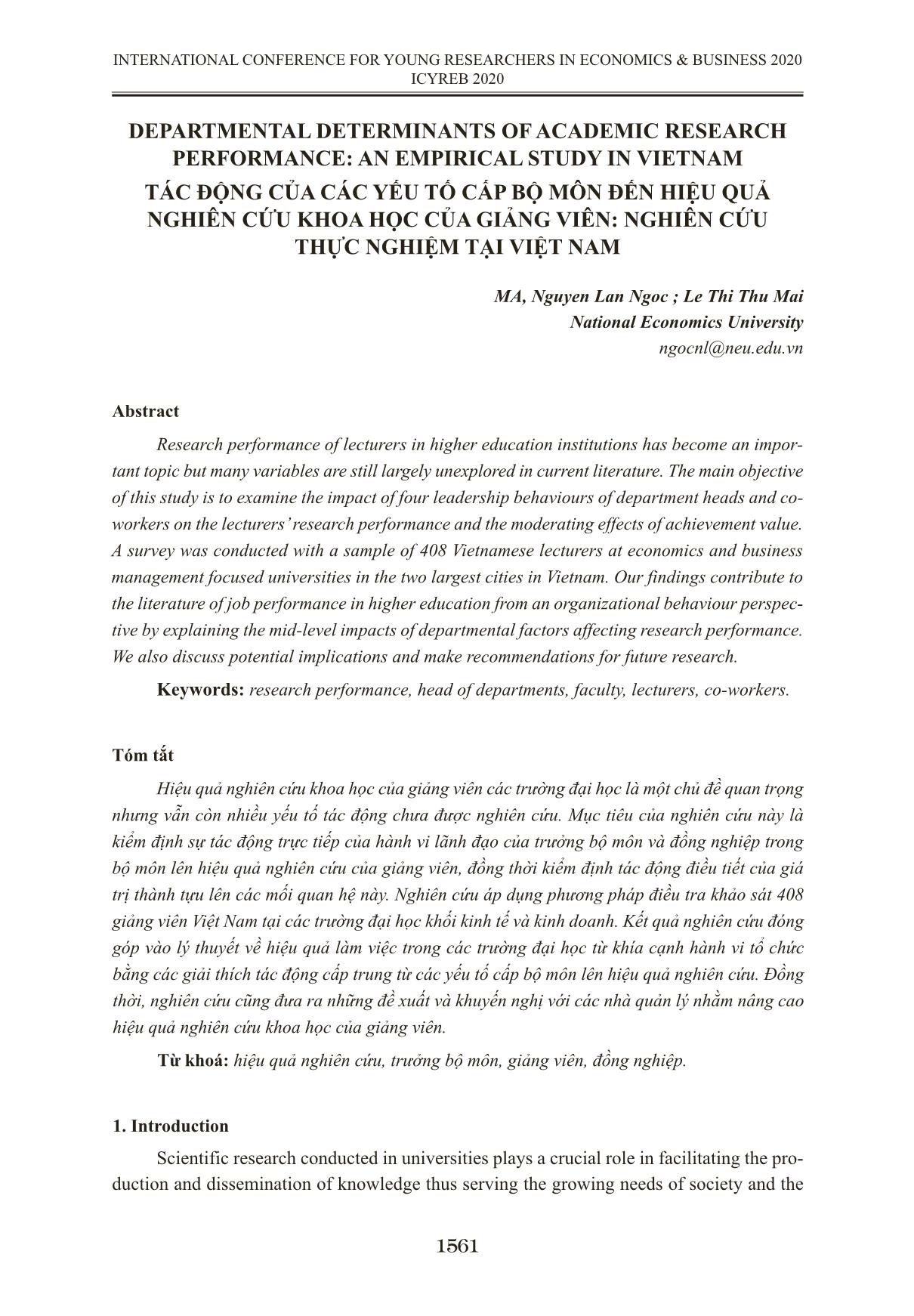
Trang 1
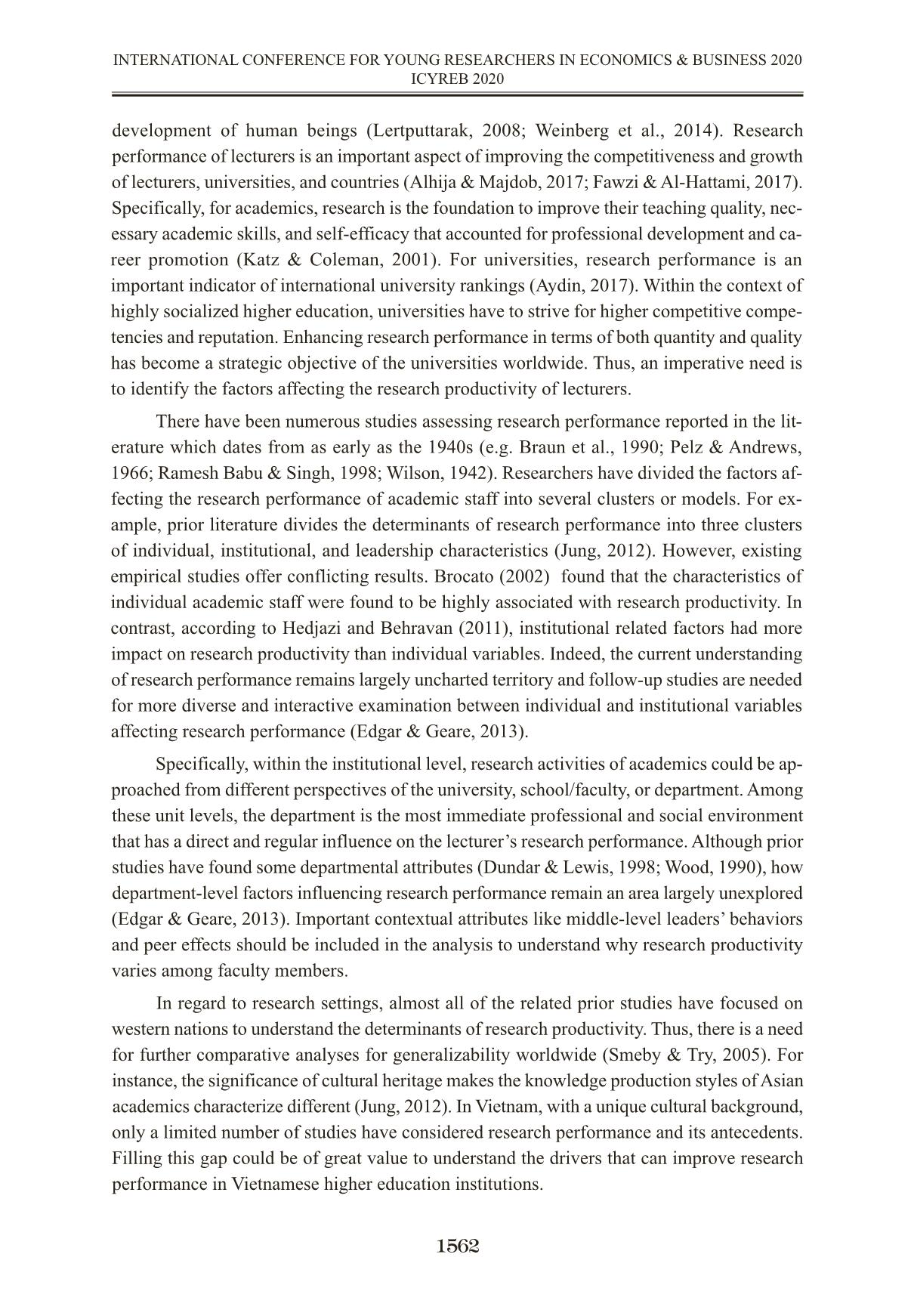
Trang 2
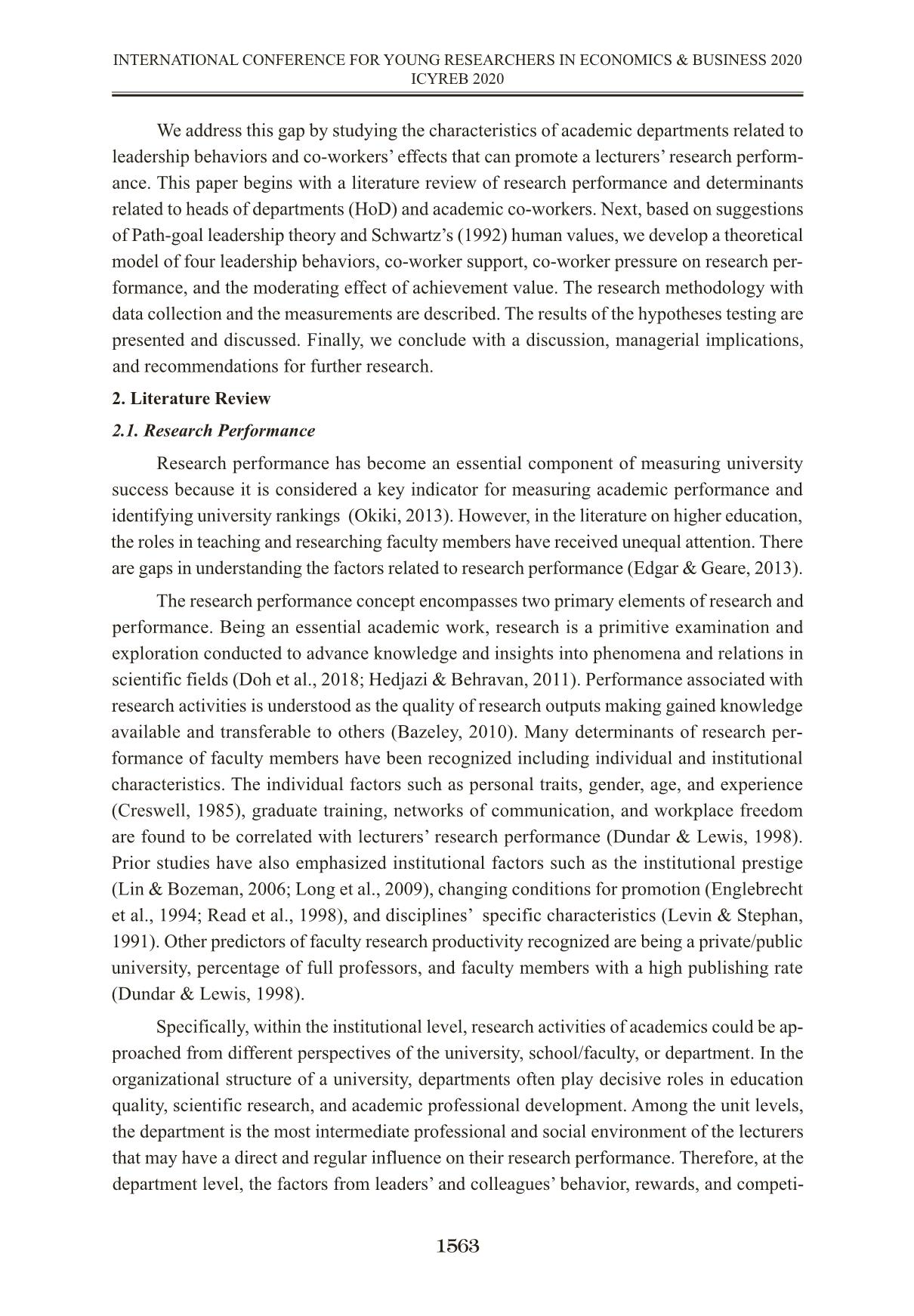
Trang 3
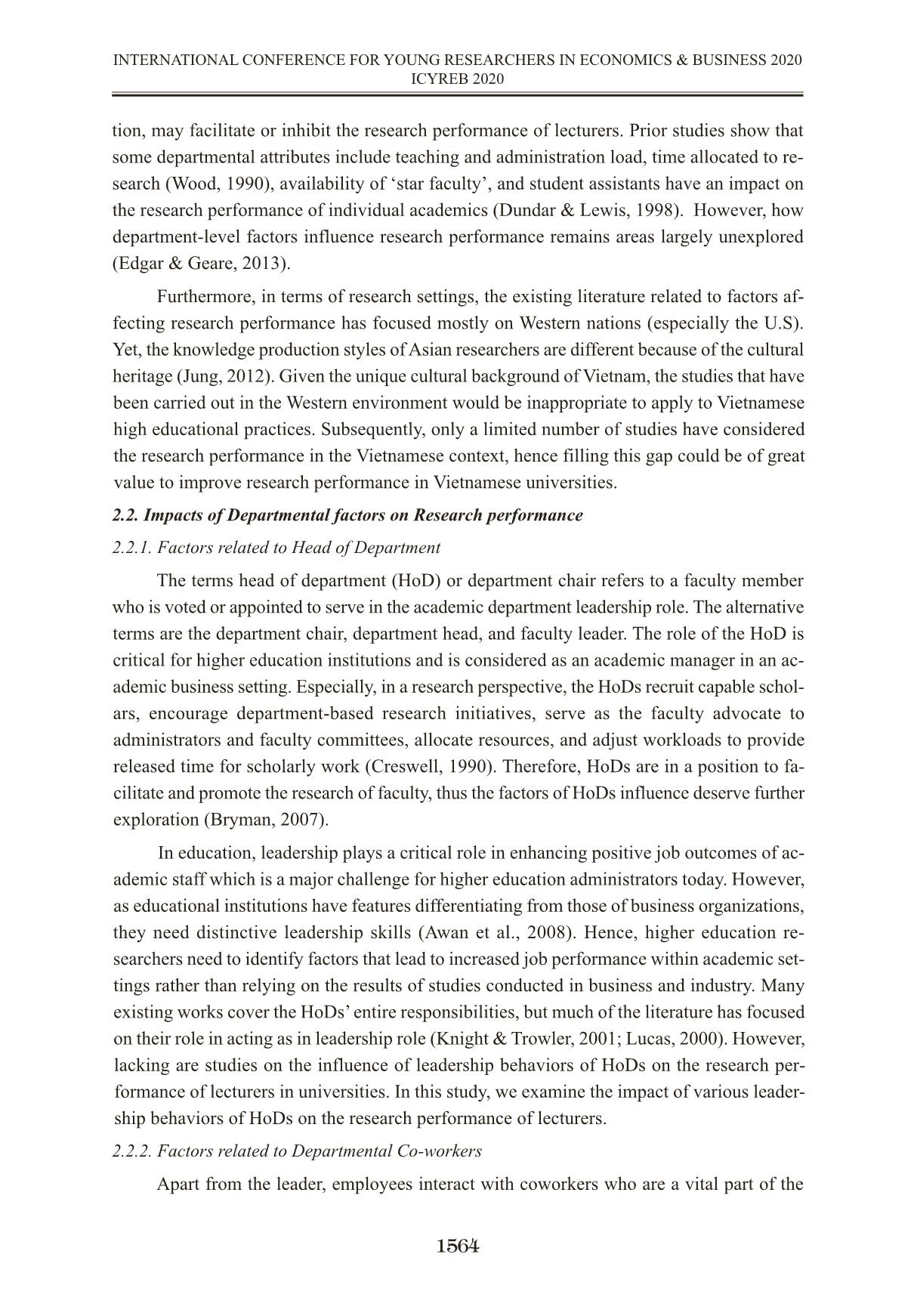
Trang 4
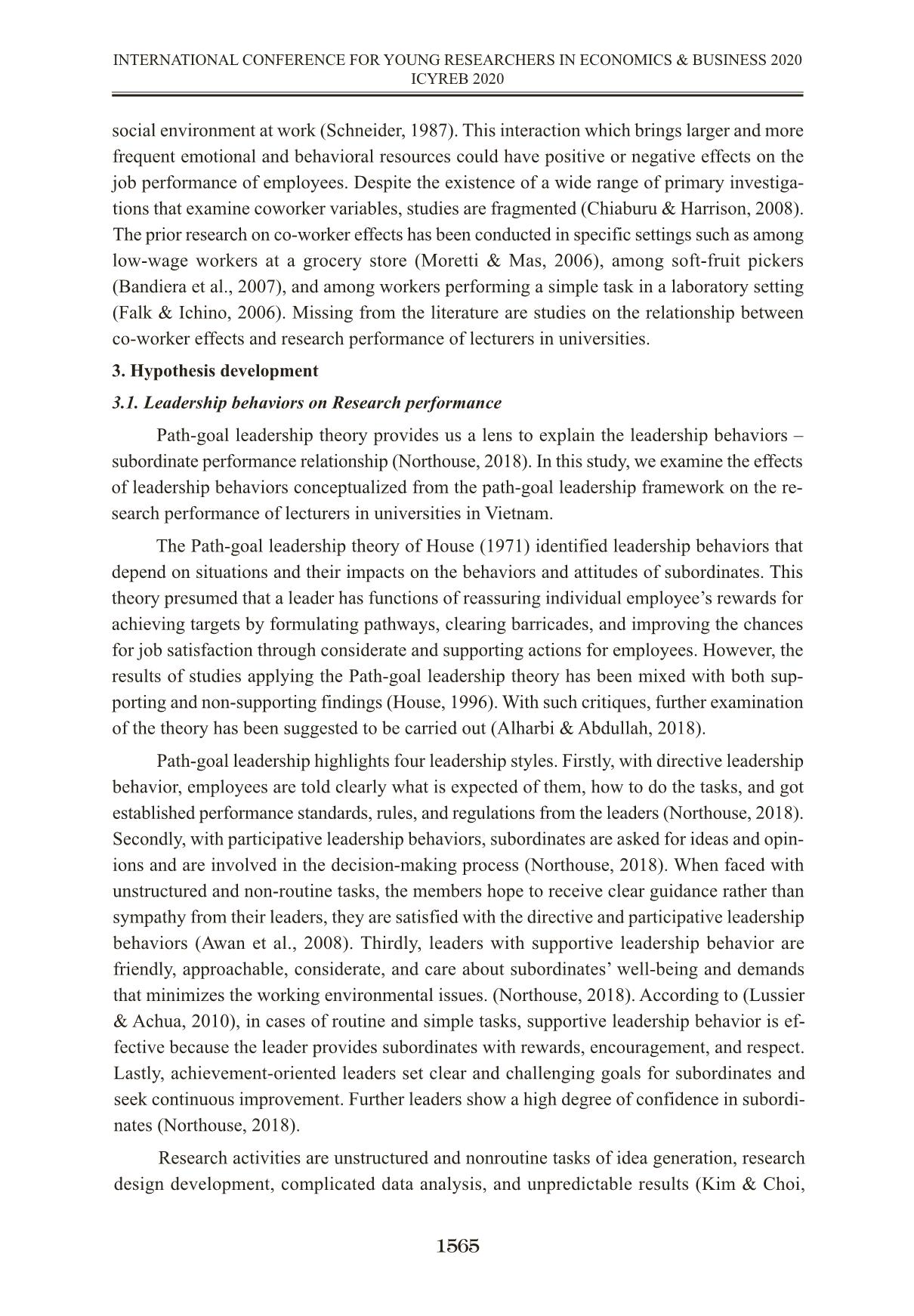
Trang 5
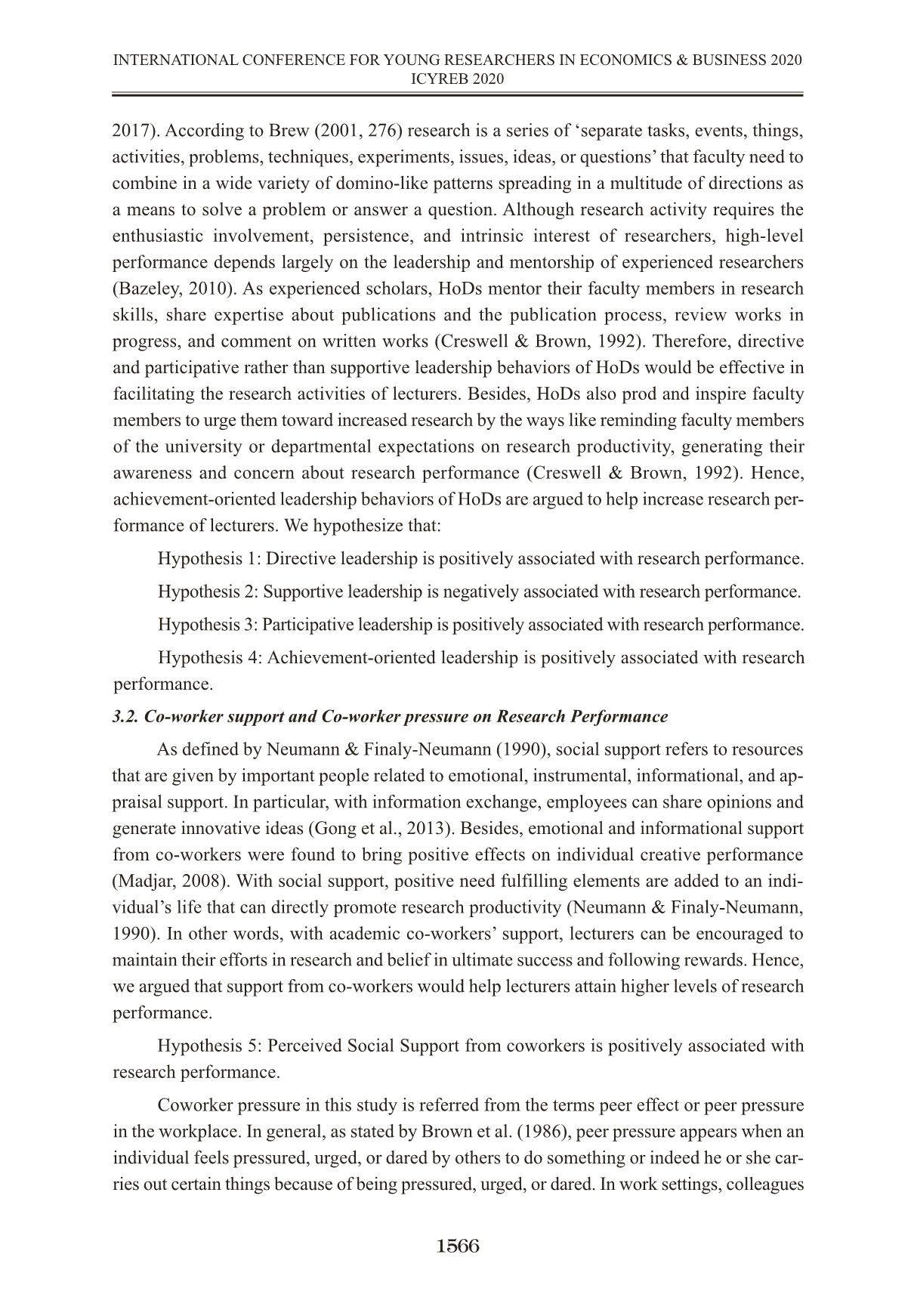
Trang 6
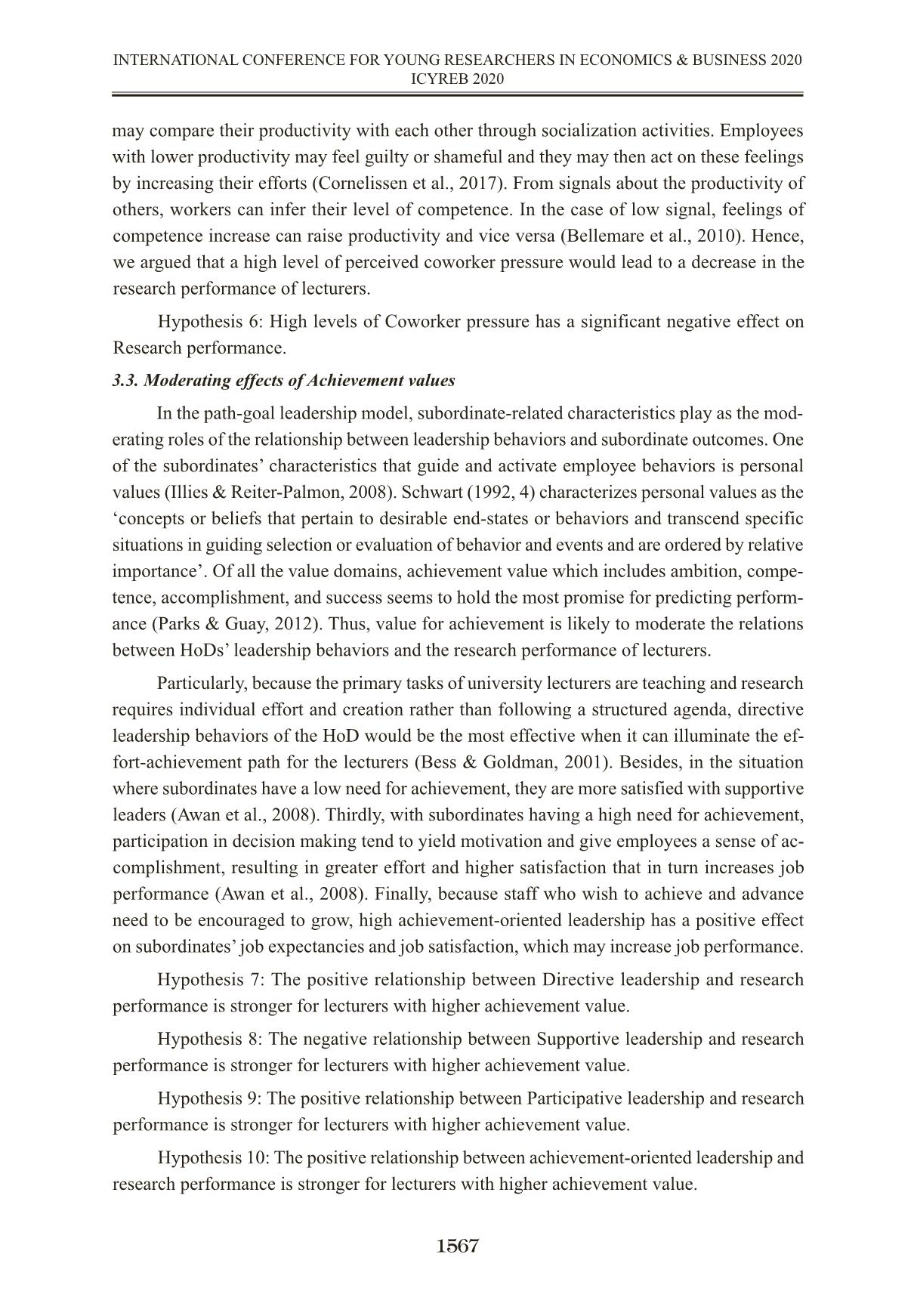
Trang 7
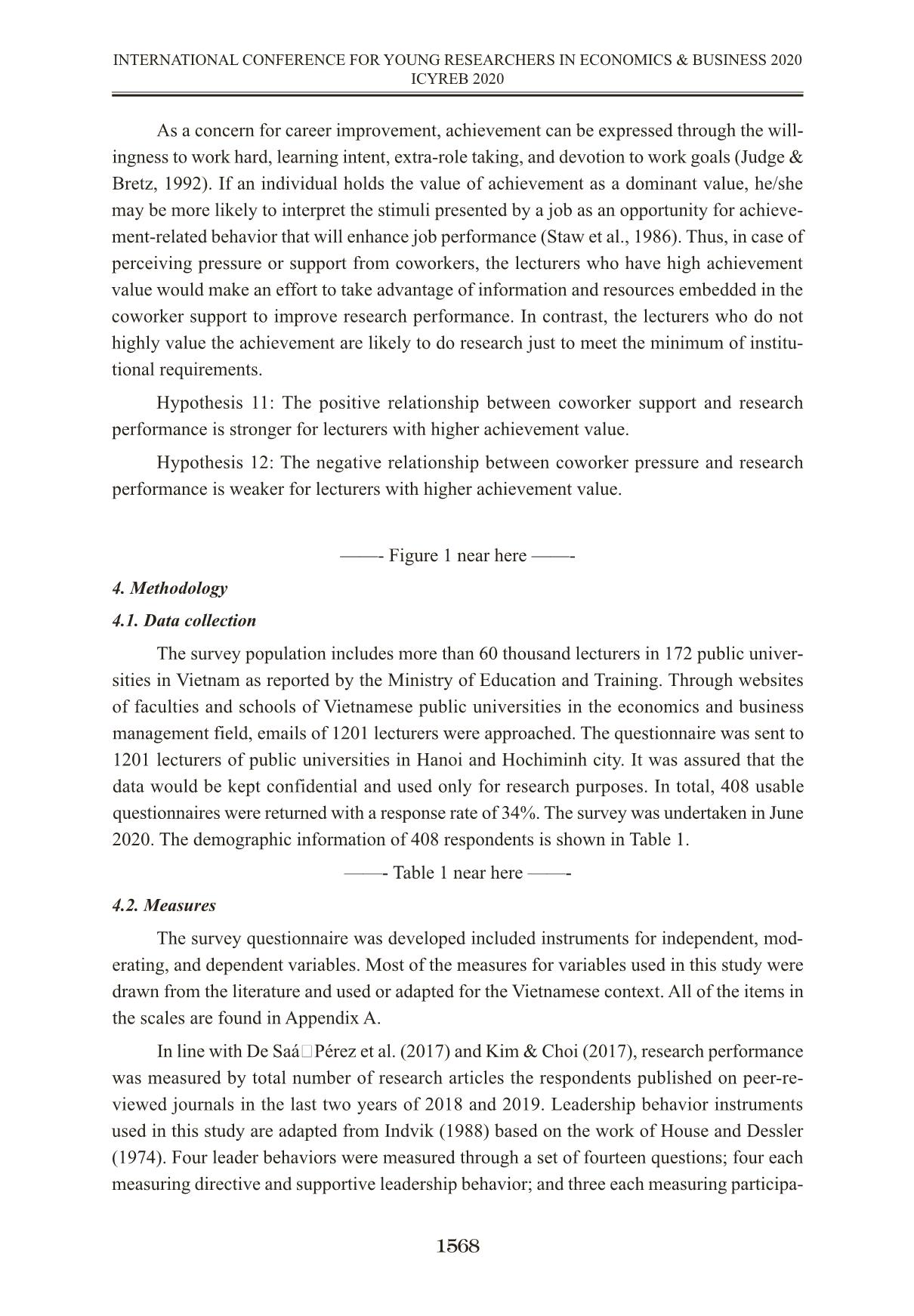
Trang 8
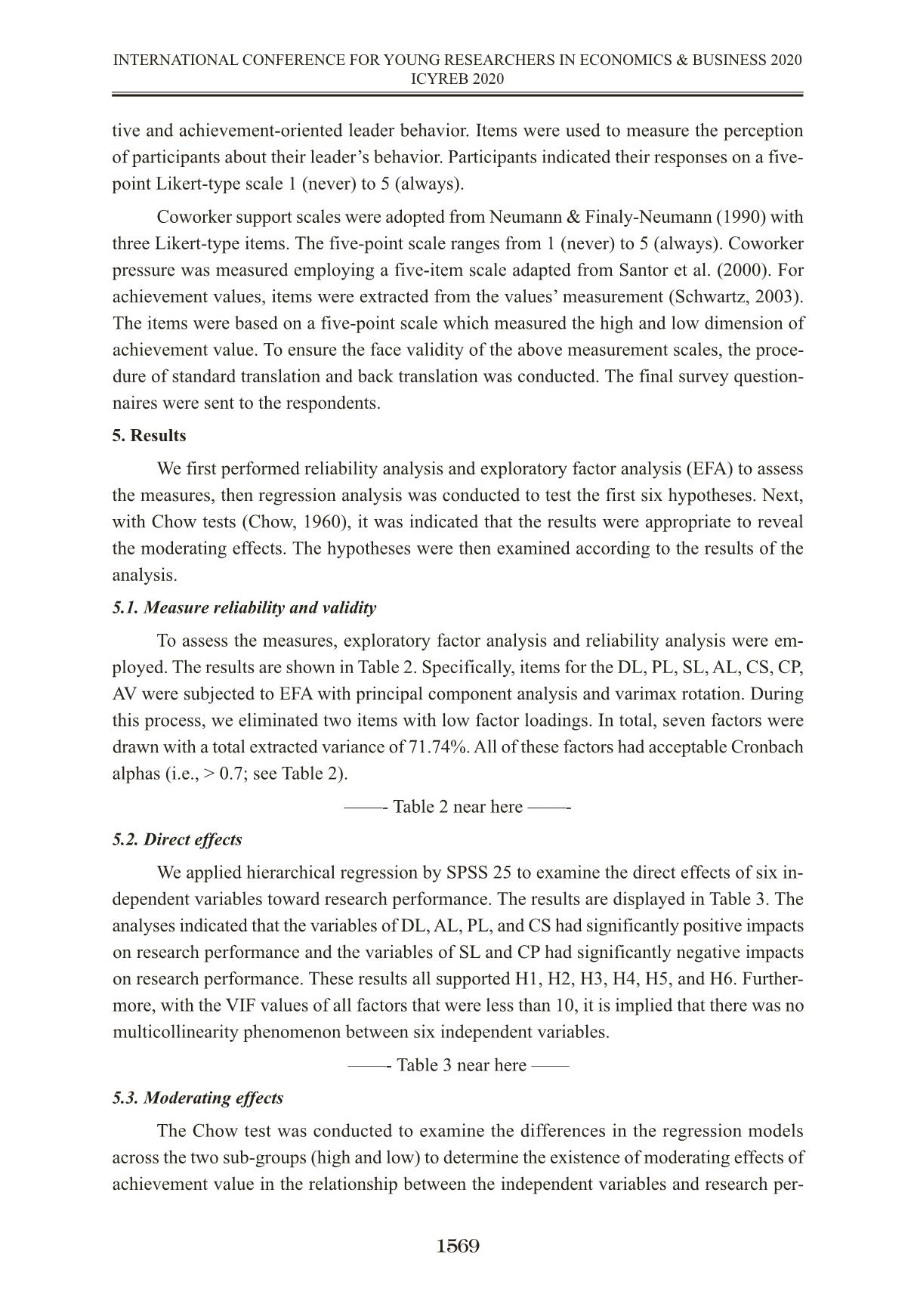
Trang 9
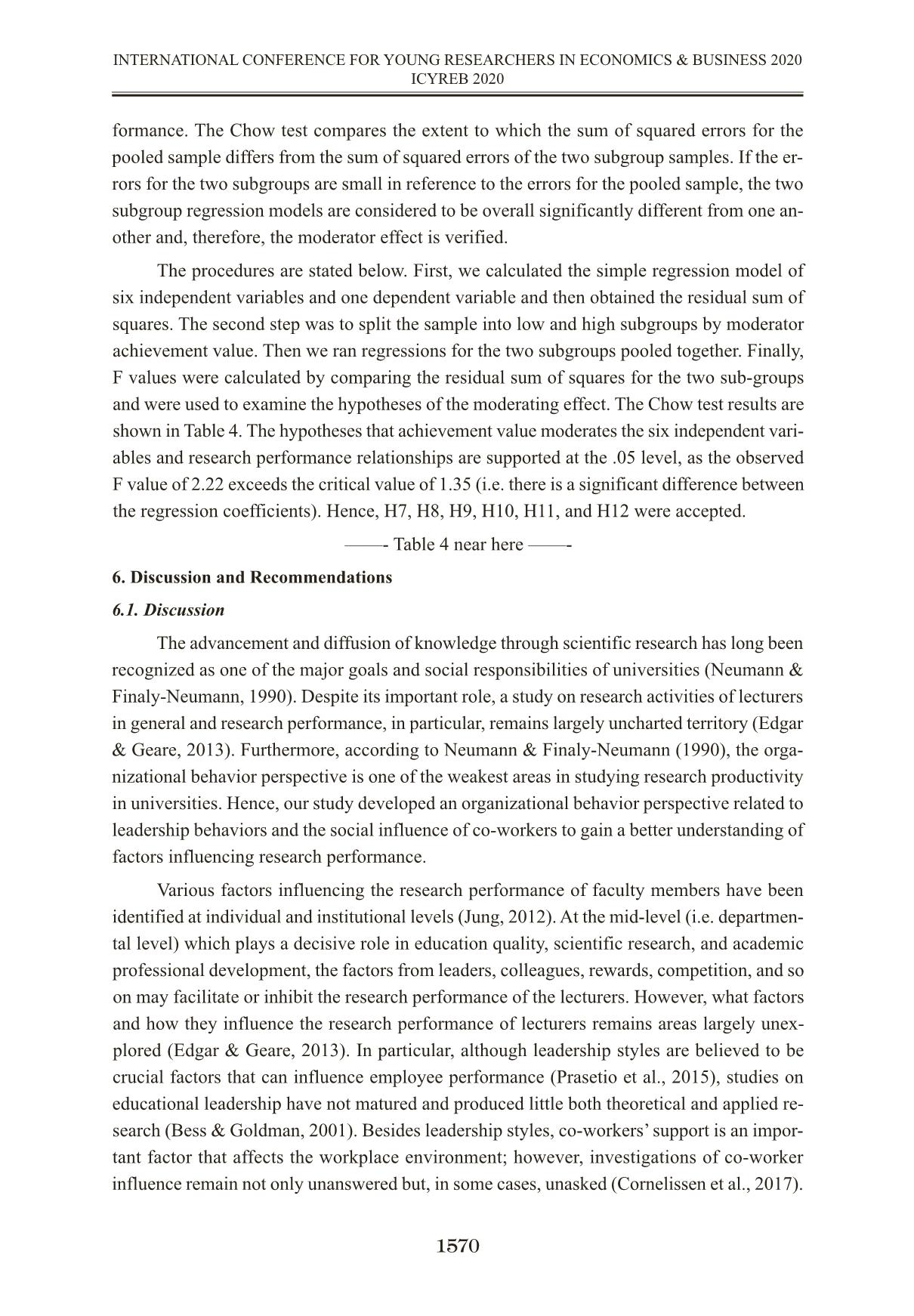
Trang 10
Tải về để xem bản đầy đủ
Tóm tắt nội dung tài liệu: Tác động của các yếu tố cấp bộ môn đến hiệu quả nghiên cứu khoa học của giảng viên: Nghiên cứu thực nghiệm tại Việt Nam
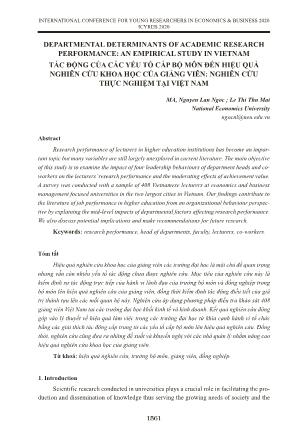
DEPARTMENTAL DETERMINANTS OF ACADEMIC RESEARCH PERFORMANCE: AN EMPIRICAL STUDY IN VIETNAM TÁC ĐỘNG CỦA CÁC YẾU TỐ CẤP BỘ MÔN ĐẾN HIỆU QUẢ NGHIÊN CỨU KHOA HỌC CỦA GIẢNG VIÊN: NGHIÊN CỨU THỰC NGHIỆM TẠI VIỆT NAM MA, Nguyen Lan Ngoc ; Le Thi Thu Mai National Economics University ngocnl@neu.edu.vn Abstract Research performance of lecturers in higher education institutions has become an impor- tant topic but many variables are still largely unexplored in current literature. The main objective of this study is to examine the impact of four leadership behaviours of department heads and co- workers on the lecturers’ research performance and the moderating effects of achievement value. A survey was conducted with a sample of 408 Vietnamese lecturers at economics and business management focused universities in the two largest cities in Vietnam. Our findings contribute to the literature of job performance in higher education from an organizational behaviour perspec- tive by explaining the mid-level impacts of departmental factors affecting research performance. We also discuss potential implications and make recommendations for future research. Keywords: research performance, head of departments, faculty, lecturers, co-workers. Tóm tắt Hiệu quả nghiên cứu khoa học của giảng viên các trường đại học là một chủ đề quan trọng nhưng vẫn còn nhiều yếu tố tác động chưa được nghiên cứu. Mục tiêu của nghiên cứu này là kiểm định sự tác động trực tiếp của hành vi lãnh đạo của trưởng bộ môn và đồng nghiệp trong bộ môn lên hiệu quả nghiên cứu của giảng viên, đồng thời kiểm định tác động điều tiết của giá trị thành tựu lên các mối quan hệ này. Nghiên cứu áp dụng phương pháp điều tra khảo sát 408 giảng viên Việt Nam tại các trường đại học khối kinh tế và kinh doanh. Kết quả nghiên cứu đóng góp vào lý thuyết về hiệu quả làm việc trong các trường đại học từ khía cạnh hành vi tổ chức bằng các giải thích tác động cấp trung từ các yếu tố cấp bộ môn lên hiệu quả nghiên cứu. Đồng thời, nghiên cứu cũng đưa ra những đề xuất và khuyến nghị với các nhà quản lý nhằm nâng cao hiệu quả nghiên cứu khoa học của giảng viên. Từ khoá: hiệu quả nghiên cứu, trưởng bộ môn, giảng viên, đồng nghiệp. 1. Introduction Scientific research conducted in universities plays a crucial role in facilitating the pro- duction and dissemination of knowledge thus serving the growing needs of society and the 1561 INTERNATIONAL CONFERENCE FOR YOUNG RESEARCHERS IN ECONOMICS & BUSINESS 2020 ICYREB 2020 development of human beings (Lertputtarak, 2008; Weinberg et al., 2014). Research performance of lecturers is an important aspect of improving the competitiveness and growth of lecturers, universities, and countries (Alhija & Majdob, 2017; Fawzi & Al-Hattami, 2017). Specifically, for academics, research is the foundation to improve their teaching quality, nec- essary academic skills, and self-efficacy that accounted for professional development and ca- reer promotion (Katz & Coleman, 2001). For universities, research performance is an important indicator of international university rankings (Aydin, 2017). Within the context of highly socialized higher education, universities have to strive for higher competitive compe- tencies and reputation. Enhancing research performance in terms of both quantity and quality has become a strategic objective of the universities worldwide. Thus, an imperative need is to identify the factors affecting the research productivity of lecturers. There have been numerous studies assessing research performance reported in the lit- erature which dates from as early as the 1940s (e.g. Braun et al., 1990; Pelz & Andrews, 1966; Ramesh Babu & Singh, 1998; Wilson, 1942). Researchers have divided the factors af- fecting the research performance of academic staff into several clusters or models. For ex- ample, prior literature divides the determinants of research performance into three clusters of individual, institutional, and leadership characteristics (Jung, 2012). However, existing empirical studies offer conflicting results. Brocato (2002) found that the characteristics of individual academic staff were found to be highly associated with research productivity. In contrast, according to Hedjazi and Behravan (2011), institutional related factors had more impact on research productivity than individual variables. Indeed, the current understanding of research performance remains largely uncharted territory and follow-up studies are needed for more diverse and interactive examination between individual and institutional variables affecting research performance (Edgar & Geare, 2013). Specifically, within the institutional level, research activities of academics could be ap- proached from different perspectives of the university, school/faculty, or department. Among these unit levels, the department is the most immediate professional and social environment that has a direct and regular influence ... nformity dispositions, and self-reported behavior among adolescents. Developmental Psy- chology, 22(4), 521. Bryman, A. (2007). Effective leadership in higher education: A literature review. Studies in Higher Education, 32(6), 693–710. Chiaburu, D. S., & Harrison, D. A. (2008). Do peers make the place? Conceptual syn- thesis and meta-analysis of coworker effects on perceptions, attitudes, OCBs, and perform- ance. Journal of Applied Psychology, 93(5), 1082. Chow, G. C. (1960). Tests of equality between sets of coefficients in two linear regres- sions. Econometrica: Journal of the Econometric Society, 591–605. Colman, A. M., Dhillon, D., & Coulthard, B. (1995). A bibliometric evaluation of the research performance of British university politics departments: Publications in leading jour- nals. Scientometrics, 32(1), 49–66. Cornelissen, T., Dustmann, C., & Schönberg, U. (2017). Peer effects in the workplace. American Economic Review, 107(2), 425–456. Creswell, J. W. (1985). Faculty Research Performance: Lessons from the Sciences and the Social Sciences. ASHE-ERIC Higher Education Report No. 4, 1985. ERIC. Creswell, J. W. (1990). The academic chairperson’s handbook. U of Nebraska Press. Creswell, J. W., & Brown, M. L. (1992). How chairpersons enhance faculty research: A grounded theory study. The Review of Higher Education, 16(1), 41–62. De SaáPérez, P., Díaz Díaz, N. L., Aguiar Díaz, I., & Ballesteros Rodríguez, J. L. (2017). How diversity contributes to academic research teams performance. R&d Man- agement, 47(2), 165–179. Doh, S., Jang, D., Kang, G.-M., & Han, D.-S. (2018). Research Funding and Perform- ance of Academic Researchers in South Korea. Review of Policy Research, 35(1), 31–60. https://doi.org/10.1111/ropr.12261 Duffy, M. K., Ganster, D. C., & Pagon, M. (2002). Social undermining in the workplace. Academy of Management Journal, 45(2), 331–351. 1574 INTERNATIONAL CONFERENCE FOR YOUNG RESEARCHERS IN ECONOMICS & BUSINESS 2020 ICYREB 2020 Dundar, H., & Lewis, D. R. (1998). Determinants of research productivity in higher education. Research in Higher Education, 39(6), 607–631. Edgar, F., & Geare, A. (2013). Factors influencing university research performance. Studies in Higher Education, 38(5), 774–792. https://doi.org/10.1080/03075079.2011.601811 Englebrecht, T. D., Iyer, G. S., & Patterson, D. M. (1994). An empirical investigation of the publication productivity of promoted accounting faculty. Accounting Horizons, 8(1), 45. Falk, A., & Ichino, A. (2006). Clean evidence on peer effects. Journal of Labor Eco- nomics, 24(1), 39–57. Fawzi, H., & Al-Hattami, A. (2017). Faculty production of research papers: Challenges and recommendations. International Journal of Humanities and Social Science, 7(2), 221–228. Gong, Y., Kim, T.-Y., Lee, D.-R., & Zhu, J. (2013). A multilevel model of team goal orientation, information exchange, and creativity. Academy of Management Journal, 56(3), 827–851. Guryan, J., Kroft, K., & Notowidigdo, M. J. (2009). Peer effects in the workplace: Ev- idence from random groupings in professional golf tournaments. American Economic Jour- nal: Applied Economics, 1(4), 34–68. Hedjazi, Y., & Behravan, J. (2011). Study of factors influencing research productivity of agriculture faculty members in Iran. Higher Education, 62, 635–647. https://doi.org/10.1007/s10734-011-9410-6 House, R. J. (1971). A path goal theory of leader effectiveness. Administrative Science Quarterly, 321–339. House, R. J. (1996). Path-goal theory of leadership: Lessons, legacy, and a reformulated theory. The Leadership Quarterly, 7(3), 323–352. House, R. J., & Dessler, G. (1974). The path-goal theory of leadership: Some post hoc and a priori tests. Contingency Approaches to Leadership, 29, 55. Illies, J. J., & Reiter-Palmon, R. (2008). Responding destructively in leadership situa- tions: The role of personal values and problem construction. Journal of Business Ethics, 82(1), 251–272. Indvik, J. (1988). A more complete testing of path-goal theory. Academy of Manage- ment, Anaheim, CA, 1. Jauch, L. R., & Glueck, W. F. (1975). Evaluation of University Professors’ Research Performance. Management Science, 22(1), 66–75. https://doi.org/10.1287/mnsc.22.1.66 Judge, T. A., & Bretz, R. D. (1992). Effects of work values on job choice decisions. Journal of Applied Psychology, 77(3), 261–271. https://doi.org/10.1037/0021-9010.77.3.261 1575 INTERNATIONAL CONFERENCE FOR YOUNG RESEARCHERS IN ECONOMICS & BUSINESS 2020 ICYREB 2020 Jung, J. (2012). Faculty Research Productivity in Hong Kong across Academic Disci- pline. Higher Education Studies, 2(4), 1–13. Katz, E., & Coleman, M. (2001). The growing importance of research at academic colleges of education in Israel. Education+ Training. Kim, K., & Choi, S. B. (2017). Influences of creative personality and working envi- ronment on the research productivity of business school faculty. Creativity Research Journal, 29(1), 10–20. Knight, P., & Trowler, P. (2001). Departmental leadership in higher education. McGraw-Hill Education (UK). Lertputtarak, S. (2008). An investigation of factors related to research productivity in a public university in Thailand: A case study. Victoria University. Levin, S. G., & Stephan, P. E. (1991). Research productivity over the life cycle: Evi- dence for academic scientists. The American Economic Review, 114–132. Lin, M.-W., & Bozeman, B. (2006). Researchers’ Industry Experience and Productivity in University–Industry Research Centers: A “Scientific and Technical Human Capital” Ex- planation. The Journal of Technology Transfer, 31(2), 269–290. https://doi.org/10.1007/s10961-005-6111-2 Long, R., Crawford, A., White, M., & Davis, K. (2009). Determinants of faculty re- search productivity in information systems: An empirical analysis of the impact of academic origin and academic affiliation. Scientometrics, 78(2), 231–260. https://doi.org/10.1007/s11192-007-1990-7 Lucas, A. F. (2000). Leading Academic Change: Essential Roles for Department Chairs. The Jossey-Bass Higher and Adult Education Series. ERIC. Lussier, R. N., & Achua, C. F. (2010). Leadership,(2010): Theory. Application, and Skill Development. Madjar, N. (2008). Emotional and informational support from different sources and employee creativity. Journal of Occupational and Organizational Psychology, 81(1), 83–100. Mairesse, J., & Turner, L. (2005). Measurement and Explanation of the Intensity of Co-publication in Scientific Research: An Analysis at the Laboratory Level. New Frontiers in the Economics of Innovation and New Technology: Essays in Honour of Paul A. David. Moretti, E., & Mas, A. (2006). Peers at work. Neumann, Y., & Finaly-Neumann, E. (1990). The support-stress paradigm and faculty research publication. The Journal of Higher Education, 61(5), 565–580. Northouse, P. G. (2018). Leadership: Theory and practice. Sage publications. Okiki, O. C. (2013). Research Productivity of Teaching Faculty Members in Nigerian Federal Universities: An Investigative Study. 1576 INTERNATIONAL CONFERENCE FOR YOUNG RESEARCHERS IN ECONOMICS & BUSINESS 2020 ICYREB 2020 Parks, L., & Guay, R. P. (2012). Can personal values predict performance? Evidence in an academic setting. Applied Psychology, 61(1), 149–173. Pellino, G. R., Blackburn, R. T., & Boberg, A. L. (1984). The dimensions of academic scholarship: Faculty and administrator views. Research in Higher Education, 20(1), 103–115. Pelz, D. C., & Andrews, F. M. (1966). Scientists in organizations: Productive climates for research and development. Prasetio, A. P., Siregar, S., & Luturlean, B. S. (2015). The effect of the leadership to- wards employee performance in the human resources department at the PLN west java and banten distribution office. International Journal of Basic and Applied Sciences, 4(1), 149. Ramesh Babu, A., & Singh, Y. (1998). Determinants of research productivity. Sciento- metrics, 43(3), 309–329. Read, W. J., Rama, D. V, & Raghunandan, K. (1998). Are publication requirements for accounting faculty promotions still increasing? Issues in Accounting Education, 13(2), 327. Santor, D. A., Messervey, D., & Kusumakar, V. (2000). Measuring peer pressure, pop- ularity, and conformity in adolescent boys and girls: Predicting school performance, sexual attitudes, and substance abuse. Journal of Youth and Adolescence, 29(2), 163–182. Schneider, B. (1987). The people make the place. Personnel Psychology, 40(3), 437–453. Schwartz, S. H. (1992). Universals in the content and structure of values: Theoretical advances and empirical tests in 20 countries. Advances in Experimental Social Psychology, 25(1), 1–65. Schwartz, S. H. (2003). A proposal for measuring value orientations across nations. Questionnaire Package of the European Social Survey, 259(290), 261. Schwartz, S. H., & Bilsky, W. (1990). Toward a theory of the universal content and structure of values: Extensions and cross-cultural replications. Journal of Personality and Social Psychology, 58(5), 878. Smeby, J.-C., & Try, S. (2005). Departmental contexts and faculty research activity in Norway. Research in Higher Education, 46(6), 593–619. Sougui, A. O., Bon, A. T., Mahamat, M. A., & Hassan, H. M. H. (2016). The Impact of Leadership on Employee Motivation in Malaysian Telecommunication Sector. Galore Inter- national Journal of Applied Sciences and Humanities, 1(1). Staw, B. M., Bell, N. E., & Clausen, J. A. (1986). The dispositional approach to job at- titudes: A lifetime longitudinal test. Administrative Science Quarterly, 31(1), 56–77. https://doi.org/10.2307/2392766 Wanjala, M. (2014). The influence of leadership style on employees’ job performance in the hospitality industry: case study of safari park hotel. United States International Uni- versity-Africa. 1577 INTERNATIONAL CONFERENCE FOR YOUNG RESEARCHERS IN ECONOMICS & BUSINESS 2020 ICYREB 2020 Weinberg, B. A., Owen-Smith, J., Rosen, R. F., Schwarz, L., Allen, B. M., Weiss, R. E., & Lane, J. (2014). Science funding and short-term economic activity. Science, 344(6179), 41–43. Wilson, L. (1942). The academic man: A study in the sociology of a profession. Trans- action Publishers. Wood, F. (1990). Factors influencing research performance of university academic staff. Higher Education, 19(1), 81–100. 1578 INTERNATIONAL CONFERENCE FOR YOUNG RESEARCHERS IN ECONOMICS & BUSINESS 2020 ICYREB 2020 Appendix A. Measurement scales Table 1. Demographic statistics 1579 INTERNATIONAL CONFERENCE FOR YOUNG RESEARCHERS IN ECONOMICS & BUSINESS 2020 ICYREB 2020 Factors Items Directive leadership behavior (DL) DL1. I let subordinates know what is expected of them. DL2. I inform subordinates about what needs to be done and how it needs to be done. DL3. I ask subordinates to follow standard rules and regulations. DL4. I explain the level of performance that is expected of subordinates. Participative leadership behavior (PL) PL1. I consult with subordinates when facing a problem. PL2. I listen receptively to subordinates’ ideas and suggestions. PL3. I ask for suggestions from subordinates concerning how to carry out assignments. Supportive leadership be- havior (SL) SL1. I maintain a friendly working relationship with subordinates. SL2. I do little things to make it pleasant to be a member of the group. SL3. I help subordinates overcome problems that stop them from carrying out their tasks. SL4. I behave in a manner that is thoughtful of subordinates’ personal needs. Achievement- oriented lead- ership behavior (AL) AL1. I let subordinates know that I expect them to perform at their highest level. AL2. I set goals for subordinates’ performance that are quite challenging. AL3. I encourage continual improvement in subordinates’ performance. Coworker support (CS) CS1. My colleagues help me solve work-related problems. CS2. My colleagues provide me with constructive feedback on my research. CS3. My colleagues support me whenever I experience a heavy workload. Coworker pressure (CP) CP1. My coworkers could push me into doing research. CP2. I give into coworker easily. CP3. If my coworkers asked me to do research, it would be hard to say no. CP4. If my coworkers are conducting research, it would be hard for me to resist doing re- search. CP5. I’ve felt pressured to research because most of my coworkers have done it. Achievement values (AV) AV1. It’s very important for him to show his abilities. He wants people to admire what he does. AV2. Being very successful is important to him. He likes to impress other people. AV3. He thinks it is important to be ambitious. He wants to show how capable he is. AV4. Getting ahead in life is important to him. He strives to do better than others. Age % Gender % Education % Department % < 30 years 12.7 Male 26.5 Bachelor 0.2 < 10 people 24.0 30 – 40 58.3 Female 73.5 Master 71.1 11 – 20 peo- 42.4 41 – 50 27.0 PhD 28.7 21 – 30 peo- 20.6 > 50 years 2.0 31 – 40 peo- 5.1 > 50 people 7.8 Table 2. Results of factor analysis and reliability analysis. Table 3. Regression result with Research performance as the dependent variable 1580 INTERNATIONAL CONFERENCE FOR YOUNG RESEARCHERS IN ECONOMICS & BUSINESS 2020 ICYREB 2020 Construct Cronbach’s α Item Mean SD Factor loading Directive leadership behavior (DL) 0.783 DL1 3.233 0.96 0.802 DL2 3.047 1.07 0.811 DL3 3.895 1.03 0.643 DL4 3.010 1.03 0.819 Participative leadership behavior (PL) 0.866 PL1 3.239 1.04 0.841 PL2 3.554 0.90 0.883 PL3 3.242 0.90 0.887 Supportive leadership behavior (SL) 0.832 SL1 4.074 0.78 0.830 SL2 3.973 0.88 0.827 SL3 3.113 1.09 0.798 SL4 3.478 0.97 0.866 Achievement-oriented leadership behav- 0.701 AL1 3.304 1.06 0.883 AL2 3.034 1.06 0.763 AL3 3.525 0.95 0.781 Coworker support (CS) 0.877 CS1 3.463 0.85 0.874 CS2 3.422 0.86 0.904 CS3 3.353 0.96 0.843 Coworker pressure (CP) 0.842 CP1 3.096 0.92 0.733 CP2 2.917 0.88 0.809 CP3 3.091 0.90 0.736 CP4 3.076 0.86 0.796 CP5 3.103 0.90 0.736 Achievement values (AV) 0.892 AV1 3.765 1.24 0.883 AV2 3.748 1.23 0.896 AV3 3.990 1.24 0.837 AV4 3.988 1.30 0.835 Model Unstandardized Standard- t Sig. Collinearity Statistics B Std. Error Beta Tolerance VIF 1 (Constant) 1.089 1.829 .595 .552 DL 1.488 .283 .298 5.251 .000 .836 1.197 SL -1.222 .288 -.230 -4.239 .000 .915 1.093 AL .706 .278 .144 2.544 .012 .844 1.185 PL .561 .259 .119 2.164 .031 .886 1.128 CS .658 .298 .123 2.212 .028 .872 1.146 CP -1.241 .326 -.203 -3.808 .000 .954 1.049 Table 4. Chow test for Achievement value as a moderator. **p<.05 Figure 1. Research model 1581 INTERNATIONAL CONFERENCE FOR YOUNG RESEARCHERS IN ECONOMICS & BUSINESS 2020 ICYREB 2020 Residual sum of squares for Total 2807.621 Low Achievement value 1427.494 High Achievement value 1273.281 Chow test (F) 2.22** R(0.05, 102. 138 1.35
File đính kèm:
 tac_dong_cua_cac_yeu_to_cap_bo_mon_den_hieu_qua_nghien_cuu_k.pdf
tac_dong_cua_cac_yeu_to_cap_bo_mon_den_hieu_qua_nghien_cuu_k.pdf

